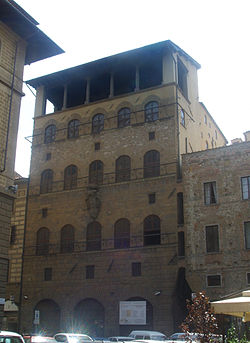- Palazzo Davanzati
-
Palazzo Davanzati is a palace in Florence, Italy. It houses the Museum of the Old Florentine House.
Contents
History
Palazzo Davanzati was erected in the second half of the 14th century by the Davizzi family, who were wealthy members of the wool guild. In 1516 it was sold to the Bartolini and, later that century, to the Davanzati family, also rich merchants (1578), who held it until 1838. After the suicide of Carlo Davanzati, it was split into different quarters and modified. After escaping the numerous demolitions of 19th century Florence, it was bought by Elia Volpi, an antiquarian, who restored in (his impression of) the original style.
In 1910, Volpi opened the building as a private museum (Museo Privato della Casa Fiorentina Antica). The contents of this museum kept changing as Volpi sold the furniture at auctions, including in a major sale of 1916 in New York. In the 1920s, Egyptian antique dealers Vitale and Leopoldo Bengujat acquired the building and its contents. In 1951 it was purchased by the Italian state and kept open as a museum. In 1995 it was closed for major restoration to consolidate the building that was falling down. The museum was partially reopened in 2005; the ground and first floors can now be visited.
Architecture
The palace consists of a facade that unifies a grouping of earlier, medieval tower homes that the owner purchased with the intent to put them together.
It is constructed in sandstone, with three large portals on the horizontal axis, and three stories of mullioned windows. The topmost floor has a loggia supported by four columns and two pilasters that was added in the 16th century. The façade displays the Davanzati coats of arms and has traces of other decorations.
The interior courtyard has arches, vaults, and capitals in 14th century-style.
Interior
The following rooms can be visited:
Ground floor: Atrium
Entered through one of three large portals. This large room was used to conduct business. Presently it used to display objects and information related to the history of the building.
Ground floor: Courtyard
All the rooms of the building communicate on to hallways that open onto the central courtyard.
First floor: Great Hall
This large room was used for conducting business. Its large windows give on to the street. There are three square holes covered by wooden covers in correspondence with the openings of the atrium below on to the street; these were used to observe who was walking in, and eventually for defense purposes. The room is now set up as a museum with a table in the center with various sixteenth century objects on display.
First floor: Sala dei Pappagalli (Room of the Parrots)
The so-called Sala dei Pappagalli has wall paintings designed to look like patchwork wall-hangings lined with miniver, with motifs of parrots painted or embroidered on the blocks. These paintings are much restored and so may not look like the original frescoes. A large fireplace dominates this room. On display is maiolica from Montelupo.
First floor: Bathroom
A small room with indoor plumbing.
First floor: Study (studiolo)
This room, which does not retain any of its original wall decoration, was probably a study. Objects on display include a forziere (locking chest), cassone, small sculptures, and paintings.
First floor: Bedroom
The Sala dei Pavoni's frescoes show instead a false geometrical tapestry and a row of coat of arms of families allied with the Davizzi. There are scenes of love, adventure and death inspired to the medieval romance of The Châtelaine de Vergy[1].
It is currently set up with a bed and cradle. There is a small ensuite bathroom.
Upper floors
The upper floors are presently closed for restoration. On the third floor is the Camera delle Impannate, a painted hall. The former kitchen is located on the last floor. When it was a museum pre 1995, it used to house a series of old tools.
References
- ^ Sebastiani, Domenico. "Un Cupido a quattro zampe". Medioevo (149): p. 47.
External links
- Official website
- arttrav Information and photos from arttrav.com
- Museums in Florence - Davanzati Palace
Coordinates: 43°46′12.45″N 11°15′10.72″E / 43.770125°N 11.2529778°E
Categories:- 14th-century architecture
- Palaces in Florence
Wikimedia Foundation. 2010.

